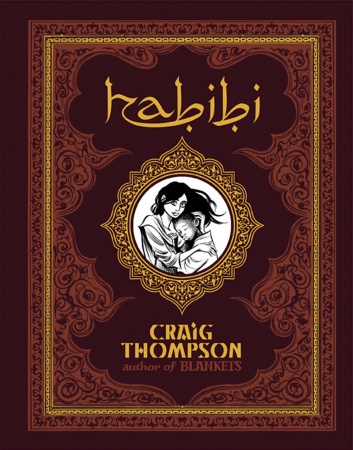Prior to this 2011, cartoonist Craig Thompson had produced two major works: the slim Good-bye, Chunky Rice volume, and the massive autobiographical tome called Blankets. Good-bye, Chunky Rice was a cute, quirky warm-up for the honest but sentimental Blankets, and the themes of the former were returned in the latter, as if Thompson realized he had a single story to tell, and stripped away all the formalistic “cartooniness” of his style and the distancing anthropomorphism to peel away the artifice and expose the truth of his own adolescence.
Both of Thompson’s first two books are worth reading, but they are too simplistic to be worthy of particularly close study. There are no mysteries or complexities between the covers of those books, just clearly articulated emotional expressions. Heart-felt, surely, but ultimately insubstantial.
Their sincerity does tend toward charming, if you allow them to be.
His follow-up to Blankets was the illustrated travel journal Carnet de Voyage, an even lesser work, but one that combined Thompson’s tendency toward self-reflection with a record of his interactions with the Europe through which he traveled. Also charming, if not groundbreaking.
In the seven years since, Thompson hasn’t published another comic book.
But now here’s Habibi, Thompson’s new work, in a hardcover edition from Pantheon.
It’s one of the very few comic books that actually deserves the “graphic novel” designation, with all that the term implies. Unlike so many other esteemed graphic novels, this is no pictorial short story with a single plotline. Nor is it a memoir posed as a novel. Nor is it an illustrated story with captions above the pictures. This is a book structured like a genuinely substantial novel, with temporal rearrangements and thematic recursion, with a detailed sense of place, and with characters who change by the end of the book.
Good-bye, Chunky Rice and Blankets are too slickly-produced to be classified as juvenilia, but it’s tempting to say that, with Habibi, Thompson has cast aside his juvenile oversimplifications and fully embraced his abilities as a cartoonist/writer. As a graphic novelist.
Habibi isn’t a perfect book. It still wraps things up with a bit too much neatness by the end. But it hovers close toward that elusive line of perfection. It’s an astonishingly beautiful book, one that demonstrates Thompson’s masterful ability to tell stories through panels, but also his ability to control form and function within a page or sequence. Habibi is also a book that challenges the reader emotionally, with some true nastiness at its core, and even if its protagonists are ultimately good-hearted and perhaps a bit too pure for the story being told around them, there’s a textual layering present in this work that we haven’t seen from Thompson, or many other graphic novelists, before.
Habibi confronts the mores of Middle Eastern society and doesn’t shy away from troubling depictions of events that we would find shocking in any context. Sex and sexuality, for example, are at the core of the story, and yet this is a book largely about the spiritual connections that tie the world together. It is both a painful work, at times, and a celebratory one. And in its exploration of spirituality, it doesn’t get bogged down by religious pedantry.
The essence of Habibi (a word that means “beloved” in Arabic) is the relationship between Dodola, frighteningly young bride and, later, concubine, and Zam, the boy Dodola raises on her own. Through much of the Thompson’s graphic novel, the two characters are separated, and their parallel stories intertwine spatially and thematically, providing a dual resonance that amplifies the climax of the book tremendously.
It’s a tragic story with a deep romanticism, a lyrical presentation of quasi-reality, like a Miyazaki film with the sensibility of Charles Dickens threaded throughout.
And it’s very, very good. One of the better books to ever earn the graphic novel designation. Of course, that label is applied to any comic book with a spine, so it’s not particularly elite company. But Thompson’s book can stand up to any of them. It’s the most major of his major works. Dangerous, profound, sorrowful, joyous, erudite, innocent, experienced, and perhaps a bit too precious. But novelistic, nonetheless. With over 600 pages of Thompson’s impressive level of craft to guide us through the ample, and deeply satisfying, layers of Habibi.
Tim Callahan reads comic books and graphic novels and writes about them for Tor.com. After fifteen consecutive weeks doing so, he’s particularly glad not to be writing about DC Comics at all this week.










